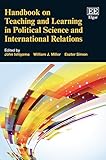Handbook on teaching and learning in political science and international relations
Publication details: London Edward Elgar 2015Description: 464p xxiiISBN:- 9781786434333
- 327.110000 ISH
| Item type | Current library | Shelving location | Call number | Status | Date due | Barcode |
|---|---|---|---|---|---|---|
 BOOKs
BOOKs
|
National Law School | REFERENCE SECTION | 327.11 ISH (Browse shelf(Opens below)) | Not For Loan | 31600 |
PART I: CURRICULUM AND COURSE DESIGN
1. Best Practices in the American Undergraduate Political Science Curriculum E. Fletcher Mcclellan;
2. Capstone Courses and Senior Seminars as Culminating Experiences in Undergraduate Political Science Education Paul E. Sum
3. Teaching Politics to Practioners John Craig;
4. Best Practices in Professional Development in Graduate Education Clodagh Harris;
5. Distance and Online Course Design J. Simon Rofe;
6. Student and Civic Engagement: Cultivating the Skills, Efficacy and Identities that Increase Student Involvement in Learning and in Public Life J. Cherie Strachan;
7. Curricular and Program Assessment Techniques in the United States Kerstin Hamann;
8. Performance Assessment in Europe Alasdair Blair;
9. Course Based Assessment and Student Feedback William J. Miller;
10. Multidisciplinary Approaches to Teaching Political Science Brenda Kauffman;
11. Promoting Information Literacy and Information Research Stephen Thornton;
12. Internationalization of the Curriculum (Bologna Process) Erkki Berndtson;
13. Promoting Employability and Jobs Skills via the Political Science Curriculum Simon Lightfoot;
PART II: TEACHING SUBJECT AREAS;
14. After the Apocalypse: A Simulation for Introduction to Politics Classes Wendy L. Watson, Jesse Hamner, Elizabeth A. Oldmixon and Kimi King;
15. Teaching Conflict and Conflict Resolution Agnieszka Paczynska;
16. Teaching about Diversity Issues Boris E. Ricks;
17. Teaching Gender Politics Fiona Buckley;
18. Teaching Graduate Research Methods Mitchell Brown;
19. Teaching Undergraduate Research Methods Cristina Leston-Bandeira;
20. Teaching Political Theory Matthew J. Moore;
21. Teaching Controversial Topics David Malet;
22. Teaching at the Community College: Faculty Role, Responsibilities and Pedagogical Techniques Erin Richards
23. Teaching International Relations Rebecca Glazier
PART III: IN CLASS TEACHING TECHNIQUES
24. Effective Syllabus Design John Ishiyama and Robert G. Rodriguez
25. Integrating Technology into the Classroom Gabriela Pleschova
26. War, Peace and Everything in Between: Simulations in International Relations Victor Asal, Chad Raymond and Simon Usherwood;
27. Developing Your Own In-Class Simulations: Design Advice and a ‘Commons’ Simulation Example Mark A. Boyer and Elizabeth T. Smith;
28. Group Work in Political Science: How To Get Collaboration into the Classroom Bobbi Gentry;
29. Designing Team-Based Learning Activities Andreas Broscheid;
30. Experiential Education in Political Science and International Relations Elizabeth Bennion;
31. Best Practices in Problem Based Learning Heidi Maurer;
32. Developing Student Scholars: Best Practices in Promoting Undergraduate Research James M. Scott;
33. Teaching International Relations with Film and Literature: Using Non-Traditional Texts in the Classroom Jennifer K. Lobasz and Brandon Valeriano;
34. Promoting Course Based Writing in the Discipline Brian Smentkowski;
35. Best Practices in Undergraduate Lecturing: How to Make Large Classes Work Kinga Kas and Elizabeth Sheppard;
36. Political Science and the Scholarship of Teaching Jeffrey L. Bernstein;
37. Getting Students to Talk: Best Practices in Promoting Student Discussion Michael P. Marks

There are no comments on this title.